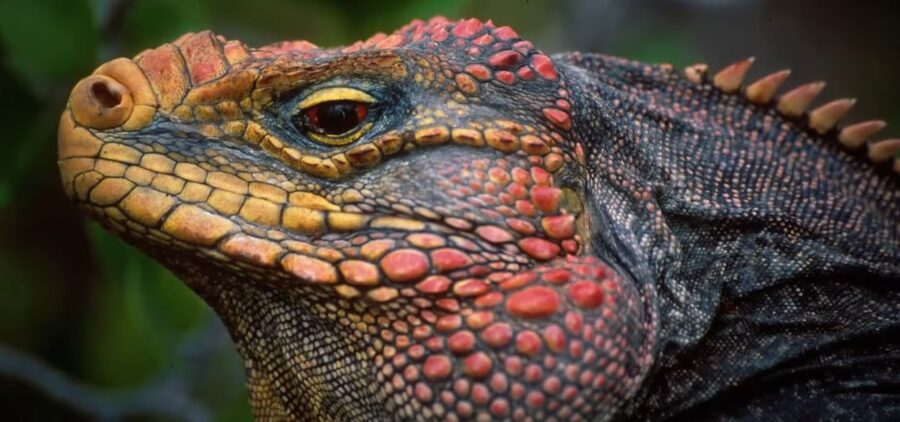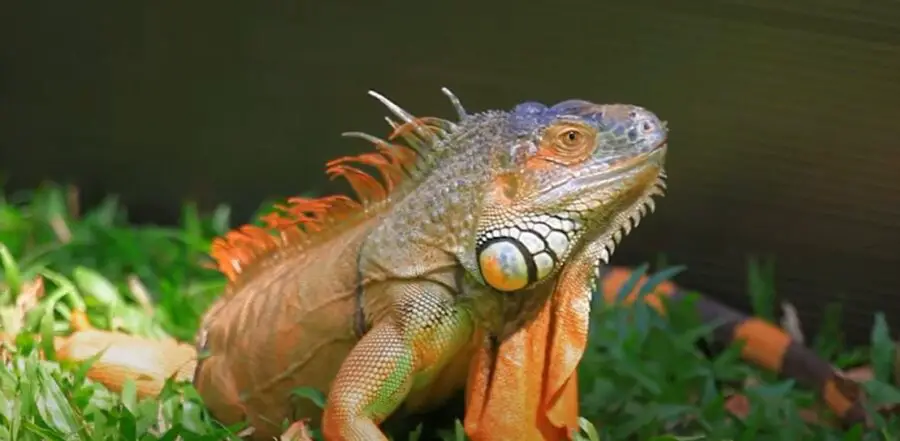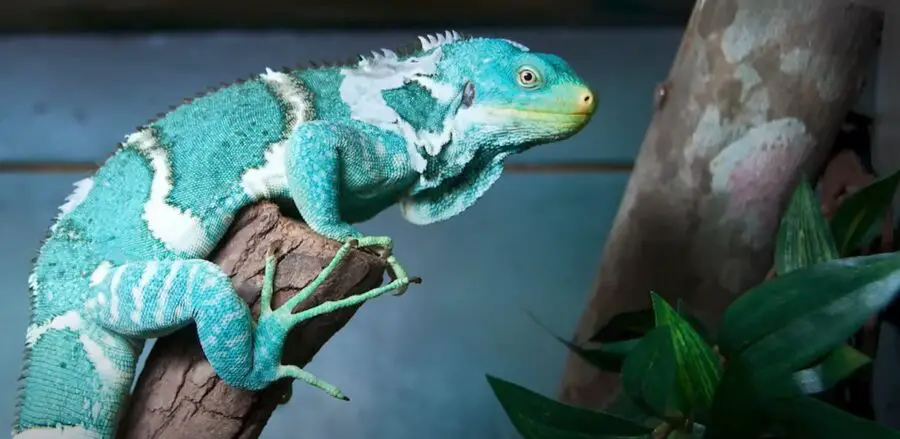My iguana gets moody. He has dark days and sometimes feels blue. Can iguanas change color?
There is much to explain in this article about how iguanas change colors and if they can camouflage.
We hope you will benefit from the information in this article that explains the reasons why iguanas change color.
Can Iguanas Change Color?
Yes. Do not expect an iguana to camouflage to blend in with their surroundings. Their color changes are much more subtle than a chameleon.
This is a larger reptile that experiences changes in shade from light to dark due to three major factors:
- Environment
- Temperature
- Health and Wellness
Allow me to explain these details below and answer more related questions on iguana color changes.

Iguana Colors
These beautiful reptiles have made their way into our homes as pets we care for due to their calm demeanor and stunning colors.
The most popular iguana is green, but you may also be lucky enough to witness, observe or care for iguanas in the following color ranges:
- Blue
- Orange
- Red
- Brown
- Yellow
When an iguana changes color however, it may not be a welcoming sight. The change could cause your reptile companion to turn dull, gray or pale as a warning sign that something is wrong with their:
- external surroundings
- internal health
Why Do Iguanas Change Color?
Here are 6 reasons to explain why iguanas change color:
- Stress
- Changes in Temperature
- Mating season
- Old age
- Poor Health
- Shedding
Top 3 Takeaways From Iguana Color Changes
- Many negative color changes are subtle and can be restored if your iguana returns to their normal health and temperament.
- Older iguanas will lose some of their vibrancy with age and the change should be gradual to not cause any concern.
- If an iguana is trying to attract a mate, they might be more colorful or brighter.
Overall, the color changes in the examples above tend to lead our reptile companions to turn slightly dull or less vibrant.
Do Iguanas Change Color When They Are Sick?
Yes. A sick or injured iguana could cause concern when you see their color turning:
- Gray
- Brown
- Dull
- Pale
Slight color shifts from time to time are normal when an iguana is undergoing shedding or they feel cold temporarily.
If the color change is less vibrant and not due to potentially trying to lure or attract a mate, then you must consider that your iguana is not feeling well.
Color changes can occur in the eyes as well. For more information on iguana eye problems, please see this article.

Can Iguanas Camouflage?
No. Camouflage is not the reason why an iguana would change color.
1. Do iguanas change color like chameleons?
No again. They are not chameleons as their much larger size could give away their location.
An iguana has to survive on its climbing ability, speed and cunning tactics to evade predators. They do not change color to blend into their surroundings.
2. Why can’t iguanas camouflage?
This is because they do not have the same pigments that expand and contract the way chameleons do.
The skin cells on a chameleon are layered to match surroundings. An iguanas would have to use their tail to smack, whack or claws to defend or climb away.
They have a mouth with a powerful jaw and many saw-like teeth to snap shut when necessary. A chameleon has more predators due to their smaller size.
Why Is My Iguana Turning Darker?
Iguanas can turn slightly darker when they are colder. Do you know that when you wear a black T-shirt compared to a white T-Shirt, you feel hotter?
The same is true for iguanas, but they don’t need to think about clothes. They can change their shade slightly or turn really dark when they are cold. They want to absorb as much heat as possible.
Cold winters for green iguanas in tropical areas that reach unseasonably cooler temperatures, leave these reptiles to figure out how to survive. They can darken their shade and take in more:
- Heat
- Sunlight
Iguana Temperature Changes
Temperature changes are a big reason why an iguana would change color. We can counteract this in captivity by creating basking zones in their enclosures.
This allows the heat lamps in these areas to provide warmth, light and comfort for our reptiles to remain vibrant or retain their natural color better.
Cold iguanas turn:
- Black
- Blue
- Darker than normal
Warm iguanas turn:
- Lighter
- Brighter
- Paler
Males iguanas During breeding season turn more:
- Orange
- Red
- Brighter

Sick Iguana Changing Color
An iguanas who is unwell can change colors with the examples below being the most common:
- Stress
- Illness
- Injuries
- Sickness
- Fungal/bacterial infections
This is obvious when you see that your iguana isn’t as colorful, bright or vibrant as they used to be. Your iguana could be stressed from a tight enclosure, temperature changes or illness.
They could be suffering from:
- Respiratory infections
- Parasites
- Bacterial or fungal skin problems
- Burns/bruises/wounds
An iguanas who is on alert or uncomfortable with high traffic, loud noises or other pets around them in the home could leave them feeling like they are perceiving threats of possible predators. This may also cause their color shift to turn more dull or dark.
Why Iguanas Change Color When Shedding
An iguana changes color in one spot, but not in another due to shedding in phases. They cannot slip out of their skin in one solid piece like a snake.
- Shedding happens in segments and certain locations where you may notice color changes happening. These patches may lighten up and change color.
- Once the old skin is removed, you may notice a brighter, pinker or more vibrant color emerging from underneath.
- You may notice the shedding occurring every few weeks in younger iguanas. The more they grow, the faster they need to shed to keep up with this change in body size.
- Adult iguanas may undergo shedding as a normal part of their lives every 4-8 weeks.
My iguanas look more gray or dull just before a shedding phase occurs. If you notice color changes in this routine type of pattern, you should not be concerned about health problems.

Which Color Iguana is Best?
No iguana color is best in my opinion. The most popular and common color is green. The green iguanas can be found in the thousands all over households and in the wild.
The more accurate number circles around a million imported green iguanas into the United states per year. Unfortunately, these green iguanas explode in population when they are released into the wild or even in urban areas.
There are even relaxed laws that allow the extermination of green iguanas in locations such as Florida for this reason. The more rare iguanas have color patterns like red, blue, yellow, pink and purple.
Sometimes these colors you see on iguanas in the wild appear when mating season approaches, Males can undergo beautiful color tones to attract females.
Frequently Asked Questions:
1. Why is my green iguana turning black?
Iguanas turn black when stressed or if they are cold. Blacker skin helps to absorb more heat and sunlight. A stressed iguana could turn darker from shades of dark gray, brown or black.
You may notice this happening from the head first, then to down their back, all the way to their tail and legs.
2. Do Iguanas change color according to mood?
It’s not as easy to say that an iguanas can shift colors as fast as a chameleon based on mood or other signals. The color changes are more gradual, but they can indicate the following:
- Even tone: Relaxed/Safe
- No splotches or patchy skin: Not shedding and healthy
- Darker shades: Angry, sick, cold
- Overall color change that is permanent: Juvenile settling into adult colors
- Red or orange: Male iguana looking to attract a female
3. Are pink iguanas real?
Pink iguanas exist and they are classified as their own species in many cases. The true pink iguanas are rare and endangered.
They only exist in select areas such as the island of Isabela on the slopes of Wolf Volcano located in the Galapagos region west of South America.
Conclusion
We are glad that you took the time to check up on your iguanas changing colors.
You are a keen observer and interested in understanding the cues, signals and methods of communication that an iguana can exemplify because they are not going to tell you with sounds.
This special creature undergoes color changes for many reasons:
- The brighter the color changes, the more positive relations to mating season, new skin after shedding or adapting and growing into their adult bodies is taking place.
- The darker the color, the more stress or temperature changes from colder rooms or outside temperatures are occurring when they need to absorb more heat.
- Dull or pale color changes are of concern about their overall health and you should look for other factors that accompany it such as lack of appetite, lethargy or abnormal feces.
Thank you for visiting PocketPetCentral.com for the best information to help you enjoy the life of your pocket pet companion in a fun, safe & healthy way.


